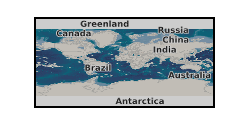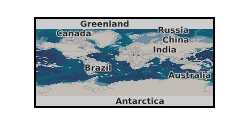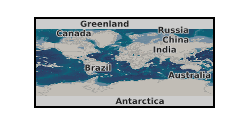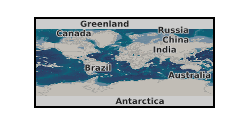Sandstone
Type of resources
Available actions
Topics
Keywords
Contact for the resource
Provided by
Years
Formats
Representation types
Update frequencies
Scale
-
Deformation of Sandstone under Crustal Pressure and Temperature Conditions (NERC Grant NE/L002485/1)

Data generated at UCL on a conventional triaxial apparatus used to deform three different sandstones at room temperature and 150 °C. The data includes the raw mechanical data (time, load, displacement, pore pressure, pore pressure volume and confining pressure) and the meaningful processed data used to plot figures and draw main conclusions (stress, strain, pore volume change, effective mean stress, inelastic strain, yield points and Youngs modulus). The three sandstones used were Bleursville, Locharbriggs and Boise Sandstone, and are denoted by data files SS, L and MBO respectively. This dataset is used in the paper: M. Jefferd, N. Brantut, P.G. Meredith and T.M. Mitchell, Compactive Deformation of Sandstone under Crustal Pressure and Temperature Conditionsserpentinite, submitted to J. Geophys. Res. And in the UCL PhD Thesis M.Jefferd, Sandstone under Crustal Pressure and Temperature
-

These images were acquired using micro computed tomographic imaging of 7 sandstone plugs taken at various depths in the Sellafield borehole 13B. SF696 (63.8 m), SF697 (76.1 m), SF698 (96.98 m), SF699 (126.27 m), SF700 (144.03 m), SF701 (172.16 m) and SF702 (181.39 m). These samples are further detailed and analysed in the following article: http://dx.doi.org/10.1144/petgeo2020-092
-

Data recorded during hydrostatic pressurisation and triaxial rock deformation experiments of Westerly granite and Darley Dale sandstone. Data consists of mechanical data (load, displacement, confining pressure) and pore pressure data (up- and downstream pore pressure, upstream intensifier volume, four pore pressure transducers mounted on sample). Contains all data necessary to evaluate the results presented in the paper entitled: 'Fluid pressure heterogeneity during fluid flow in rocks: New laboratory measurement device and method' by Brantut and Aben, submitted to Geophysical Journal International, and available at arXiv (arXiv:2006.16699).
-

Rhenium-osmium abundance and isotope data obtained for the Kyoei-Sakin-zawa Creek Section, Japan. Sample collection August 2021 principally funded by NSF-NERC award. The approximately 340 m stratigraphically thick Cretaceous section mainly comprises organic bearing siltstone, sandstone and interbedded tuff horizons associated with the OAE1d (Oceanic Anoxic Event 1d) interval.
-

Loan IDA number - IDA271576. No data was obtained for microbial cultivation experiments with core samples SSK111460 and SSK111461 from UKGEOS Glasgow Observatory, borehole GGC01. Samples and data are derived from the UK Geoenergy Observatories Programme funded by the UKRI Natural Environment Research Council and delivered by the British Geological Survey. Attached document described methodology of enriching sandstone core (SSK111461) in different media types and shale core (SSK111460) in synthetic groundwater. No microbial growth was seen after 7 months.
-

Porosity of core samples SSK111464 (sandstone) and SSK111465 (shale) calculated using backscatter electron SEM images of carbon coated thin sections processed in ImageJ Fiji software. 85 images of SSK111464 (sandstone) used and 74 images of SSK111465 (shale) at various magnifications. Core samples from UKGEOS Glasgow Observatory, borehole GGC01. Samples and data are derived from the UK Geoenergy Observatories Programme funded by the UKRI Natural Environment Research Council and delivered by the British Geological Survey.
-

Microbial DNA concentrations from DNA extraction using Qiagen PowerSoil Pro DNA Extraction kit and subsequent Polymerase Chain Reaction (PCR) from core samples collected and preserved for microbiology (SSK105556 and SSK105560) from UKGEOS Glasgow Observatory, borehole GGC01. DNA extractions and subsequent amplification using PCR indicate levels of microbial DNA below detection limits. NERC grant SHAPE-UK NE/R018006/1.
-

This dataset contains pore pressure measurements from the Bunter Sandstone Formation across the Southern North Sea of the UK Continental Shelf including quadrants 41 -50. The pressure measurements have been collected from released offshore legacy well records available from the UK National Data Repository (NDR) which is managed and served by the North Sea Transition Authority (NSTA). The data were compiled by British Geological Survey researchers in support of research projects seeking to evaluate the potential of the Bunter Sandstone Formation for storage of carbon dioxide. These projects were funded by United Kingdom Research and Innovation (UKRI). The dataset comprises direct pressure measurements from formation pressure testers (downhole tools containing a probe and packer on a retractable pad, a pretest chamber and pressure gauges) as well as formation pressure estimates from Drill Stem Tests (DST). Most of the measurements comprise results from Schlumberger’s Repeat Formation Tester (RFT), Formation Multi Tester (FMT) and Modular Dynamics Tester (MDT) tools.
-

EPSRC grant EP/L012227/1: Development of Unified Experimental and Theoretical Approach to Predict Reactive Transport in Subsurface Porous Media. The effect of pore-scale heterogeneity on non-Darcy flow behaviour is investigated by means of direct flow simulations on 3-D images of Bentheimer sandstone and Estaillades carbonate. The critical Reynolds number indicating the cessation of the creeping Darcy flow regime in Estaillades carbonate is two orders of magnitude smaller than in Bentheimer sandstone, and is three orders of magnitude smaller than in the beadpack. Also available at https://www.digitalrocksportal.org/projects/11, DOI:10.17612/P77P49. Further details can be found in Bagus P. Muljadi, Martin J. Blunt, Ali Q. Raeini, Branko Bijeljic. The impact of porous media heterogeneity on non-Darcy flow behaviour from pore-scale simulation. Advances in Water Resources. 2015. http://dx.doi.org/10.1016/j.advwatres.2015.05.019.
-

These images were acquired using micro computed tomographic imaging of 4 sandstone plugs taken at various depths in the Glasgow UKGEOS borehole GGC01. GG496 (170.07 m), GG497 (168.66 m), GG498 (73.37 m) and GG499 (135.06 m). These samples are further detailed and analysed in the following article: http://dx.doi.org/10.1144/petgeo2020-092.
 NERC Data Catalogue Service
NERC Data Catalogue Service